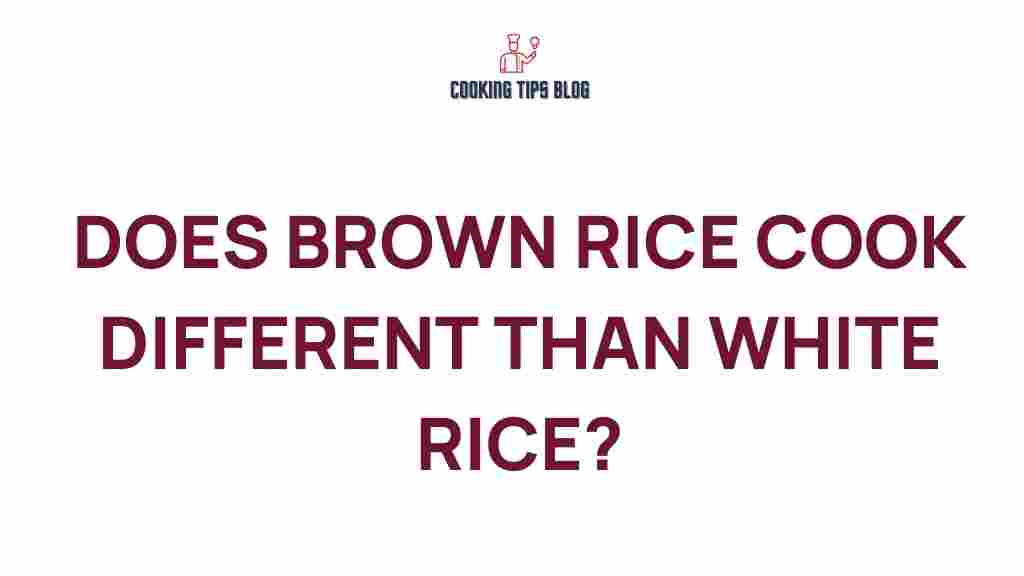Unveiling the Secrets: Does Brown Rice Cook Differently Than White Rice?
When it comes to preparing rice, many home cooks often find themselves torn between brown rice and white rice. While both varieties are staples in various cuisines around the globe, their cooking methods, nutritional profiles, and flavors differ significantly. This article will delve into whether brown rice cooks differently than white rice and provide you with the information you need to master both types. Let’s explore the reasons behind their differences and how you can best prepare brown rice in your kitchen.
Understanding Brown Rice and White Rice
Before we dive into the cooking differences, it’s essential to understand what sets brown rice apart from white rice. The primary distinction lies in the milling process:
- Brown Rice: This is whole grain rice that retains its bran and germ layers, making it more nutritious.
- White Rice: This rice has been milled to remove the bran and germ, resulting in a softer texture but fewer nutrients.
Because of these differences, brown rice tends to have a chewier texture and nuttier flavor compared to white rice. Additionally, brown rice is rich in fiber, vitamins, and minerals, making it a healthier choice for many. However, it also requires a different cooking approach.
How to Cook Brown Rice
Cooking brown rice may seem daunting, but with the right method, you can achieve perfectly fluffy grains. Here’s a step-by-step guide on how to prepare brown rice:
Ingredients Needed
- 1 cup of brown rice
- 2 to 2.5 cups of water or broth
- Salt (optional)
Step-by-Step Cooking Process
- Rinse the Rice: Start by rinsing your brown rice under cold water to remove excess starch, which can make the rice gummy.
- Measure Water: Use a ratio of 2 to 2.5 cups of water for every cup of brown rice. The exact amount may vary based on the brand and type of rice.
- Boil Water: In a saucepan, bring the water or broth to a boil. If desired, add a pinch of salt for flavor.
- Add Rice: Once the water is boiling, add the rinsed brown rice. Stir briefly to prevent sticking.
- Simmer: Reduce the heat to low, cover the saucepan, and let it simmer for about 45 to 50 minutes. Avoid lifting the lid too often.
- Check for Doneness: After the time is up, check if the rice has absorbed all the water. If there’s still water left, let it simmer for an additional 5-10 minutes.
- Fluff and Serve: Once cooked, remove the saucepan from heat and let it sit covered for 10 minutes. Then, fluff the rice with a fork and serve.
Cooking White Rice: A Quick Comparison
For those accustomed to cooking white rice, here’s a quick comparison:
- Rinse the Rice: Similar to brown rice, rinse the white rice to remove excess starch.
- Measure Water: Use a ratio of 1.5 to 2 cups of water for every cup of white rice.
- Boil & Simmer: Bring the water to a boil, add the rice, cover, and then simmer for about 15 to 20 minutes.
- Fluff and Serve: Let it sit for 5 minutes, fluff, and enjoy.
As you can see, brown rice requires about twice the cooking time and more water than white rice, which is one of the primary reasons they cook differently.
Common Troubleshooting Tips for Cooking Brown Rice
Even with the best instructions, you may encounter some challenges when cooking brown rice. Here are a few troubleshooting tips:
- Rice Too Hard: If your brown rice is still hard after the cooking time, add a little more water (about 1/4 cup) and continue to simmer, covered, until it’s tender.
- Rice Too Mushy: If your rice turns out mushy, it may have been overcooked or had too much water. Reduce your water next time.
- Sticking to the Pot: To prevent sticking, make sure to rinse the rice thoroughly before cooking and use a non-stick pot if possible.
Health Benefits of Brown Rice
Choosing brown rice over white rice can offer several health advantages:
- Higher Nutritional Value: Brown rice contains more fiber, antioxidants, and essential nutrients.
- Improved Digestion: The fiber content helps regulate digestion and maintain gut health.
- Lower Glycemic Index: Brown rice has a lower glycemic index, making it a better option for blood sugar control.
Storage Tips for Brown Rice
To maintain the quality of your brown rice, follow these storage tips:
- Uncooked Brown Rice: Store in a cool, dry place in an airtight container. It can last up to six months.
- Cooked Brown Rice: Refrigerate cooked rice in a sealed container for up to four days or freeze for up to six months.
Conclusion
In conclusion, brown rice does indeed cook differently from white rice, mainly due to its outer bran layer and the additional time and water required for cooking. Understanding these differences will help you achieve the perfect texture and flavor for your dishes. Whether you’re looking to enhance your meals with the nutty flavor of brown rice or simply want a healthier alternative, mastering the cooking techniques for both brown and white rice will elevate your culinary skills.
For more information on the benefits of whole grains like brown rice, check out this comprehensive guide. Happy cooking!
This article is in the category Healthy and created by Cookingtipsblog Team
